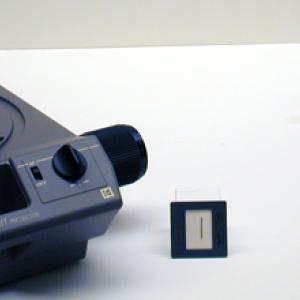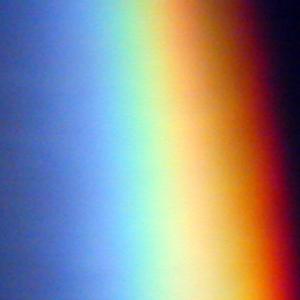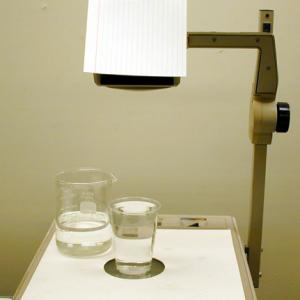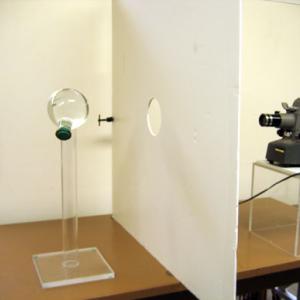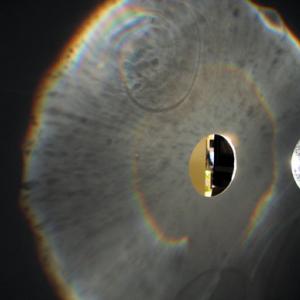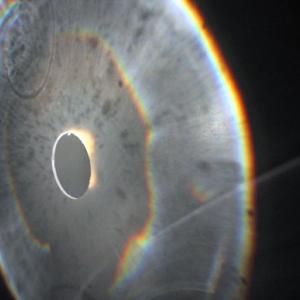College of Liberal Arts & Sciences
6A46.10 - Rainbow - Water
Place the slit slide into the 35 mm projector and direct the light towards one end of the beaker filled with water. Once focused correctly a fair rainbow should be produced. The reds and oranges will be really apparent but the blues and greens are only produced if the apparatus is in proper alignment. NOTE: The intensity of the spectrum can be greatly increased by attaching some type of mirror backing to the back side of the beaker.
A circular rainbow can be produced on the overhead projector. Place the mask with 4 inch hole on the projector. Then place the clear glass cup in the hole and fill to about 1/8 inch from the top with water. Use a piece of cardboard to block the exit beam from the lens system. When the overhead is turned on a circular rainbow should appear on the ceiling.
A rainbow from a drop can be simulated by filling a round flask with water. Place a large cardboard mask with a hole in the center in the middle of the table. Place the flask at the same height as the hole and on one side of the mask. Place the filmstrip projector on the other side of the mask, pointing through the hole and at the flask. Turn on the projector, and the rainbow should appear on the same side of the mask as the raindrop. A secondary bow can be seen if you look closely.
An interesting outdoor activity would be to take a Polaroid filter and look at a rainbow. The rainbow will be quite bright in one orientation, but will have a reduced intensity when rotated. This polarization is due to the way light is reflected at the back of each raindrop.
- Yuan Zheng, Kexun Shen, Xianghe Wang, Xing-Xing Yao, "Rainbows in Different Refractive Indices", TPT, Vol. 61, #5, May 2023, p. 351.
- Paul Hewitt, "Figuring Physics", TPT, Vol. 60, #8, Nov. 2022, p. 627.
- Bruce J. Ackerson, "Backscattering Observations From an Airplane", TPT, Vol. 58, #8, Nov. 2020, p. 593.
- Jukka O. Mattila, "Rainbows Not Due to Total Internal Reflection", TPT, Vol. 58, #6, Sept. 2020, p. 372.
- Paul Hewitt, "Figuring Physics", TPT, Vol. 58, #4, April 2020, p. 276.
- Jennifer Birriel and Ignacio Birriel, "Review Mirror Rainbow: An Optics Investigation", TPT, Vol. 58, #3, Mar. 2020, p. 164.
- Kenneth W. Ford, "Rainbows: A Graphical Approach", TPT, Vol. 58, #3, Mar. 2020, p. 152.
- Mark Welter, "Another Rainbow Demonstration with a Glass Sphere", TPT, Vol. 57, #5, May 2019, p. 344.
- Walter S. Santos, "The Goldfish Over the Rainbow", TPT, Vol. 51, #9, Dec. 2013, p. 522.
- David A. Cornell, "Rainbow Near Midday", TPT, Vol. 50, #9, Dec. 2012, p. 552.
- Hakan Isik and Kemal Yurumezoglu, "Two Simple Activities to Bring Rainbows into the Classroom", TPT, Vol. 50, #1, Jan. 2012, p. 38.
- David P. Maroun, "A Warning for Students", TPT, Vol. 46, #9, Dec. 2008, p. 517.
- Martin Lieberherr, "More Figuring Rainbows", TPT, Vol. 44, #6, Sept. 2006, p. 330.
- Roger H. Stuewer, "Figuring Rainbows", TPT, Vol. 44, #6, Sept. 2006, p. 330.
- Paul Hewitt, "Figuring Physics: Rainbow", TPT, Vol. 44, #5, May 2006, p. 268.
- Archibald W. Hendry, "A Triple Rainbow?", TPT, Vol. 41, #8, Nov. 2003, p. 460.
- Mikolaj Sawicki and Pawel Sawicki, "Supernumerary Rainbows", TPT, Vol. 38, #1, Jan. 2000, p. 19.
- Edward Pascuzzi, "The Glorious Glory", TPT, Vol. 36, #3, Mar. 1998, p. 164.
- Paul Hewitt, "Figuring Physics: How to Photogragh a Rainbow", TPT, Vol. 36, #3, Mar. 1998, p. 162.
- Albert A. Bartlett, "One in a Million. The Orthogonality of Anti‐Crepuscular Rays and Rainbows", TPT, Vol. 34, #4, Apr. 1996, p. 216.
- Paul G. Hewitt, "On Teaching Why a Rainbow Is Bowshaped", TPT, Vol. 28, #7, Oct. 1990, p. 509.
- Donald Olson, Chris Brozovich, Jacob Carr, Heather Hatton, George Miles Jr., and Greg Zwicke, "Monte Carlo Computer Simulation of a Rainbow", TPT, Vol. 28, #4, Apr. 1990, p. 226.
- A. Tan and Tom King, "Solar Zenith and Local Time from a Rainbow", TPT, Vol. 28, #4, Apr. 1990, p. 224.
- John C. Eliason Jr., "Dispersion in Spherical Water Drops", TPT, Vol. 27, #4, Apr. 1989, p. 264.
- R. D. Russell, "A Rainbow for the Classroom", TPT, Vol. 27, #4, Apr. 1989, p. 262, and referenced in Resource Letter TLC-1 Teaching Light and Color, Demonstration Experiments Resource Articles.
- M. Eugene Rudd, "The Rainbow and the Achromatic Telescope: Two Case Studies", TPT, Vol. 26, #2, Feb. 1988, p. 82.
- "The Colors In a Rainbow", TPT, Vol. 24, #7, Oct. 1986, p. Centerfold Section.
- Fred B. Royalty, "Making Rainbows in the Classroom", TPT, Vol. 22, #8, Nov. 1984, p. 523.
- R. W. Robinett, "Homemade Rainbows: A Backyard Experiment", TPT, Vol. 21, #6, Sept. 1983, p. 388.
- Samuel Derman, "Solar Spectrum Projection", TPT, Vol. 16, #1, Jan. 1978, p. 58, also A Potpourri of Physics Teaching Ideas - Optics and Waves, p. 177.
- G. David Scott, "The swimmer's twin rainbows", AJP, Vol. 43, #5, May 1975, p. 460.
- Helene F. Perry, "Making Rainbows with a Garden Hose", TPT, Vol. 13, #4, Apr. 1975, p. 197.
- Robert J. Whitaker, "Physics of the Rainbow", TPT, Vol. 12, #5, May 1974, p. 283.
- William T. Kabisch, "Seeing an Invisible Rainbow", TPT, Vol. 10, #3, Mar. 1972, p. 156.
- "Little Stinkers: The Rainbow", TPT, Vol. 3, #5, May 1965, p. 233.
- "Little Stinkers: The Rainbow", TPT, Vol. 3, #4, Apr. 1965, p. 186.
- David Skålid Amundsen, Camilla Nestande Kirkemo, Andreas Nakkerud, Jørgen Trømborg, and Arnt Inge Vistnes, "The Rainbow as a Student Project Involving Numerical Calculations", AJP, Vol. 77, #9, Sept. 2009, p. 795.
- Alan E. Shapiro, "Comment on "Newton's Zero-Order Rainbow: Unobservable or Nonexistent?" by C. F. Bohren and A. B. Fraser (AJP, Vol. 59, #4, Apr. 1991, p. 325", AJP, Vol. 60, #8, Aug. 1992, p. 749.
- Craig F. Bohren and Alistair B. Fraser, "Newton's Zero-Order Rainbow: Unobservable or Nonexistent?", AJP, Vol. 59, #4, Apr. 1991, p. 325.
- Harold A. Daw, "A 360° Rainbow Demonstration", AJP, 58, #6, June 1990, p. 593.
- Frank S. Crawford, "Rainbow Dust", AJP, Vol. 56, #11, Nov. 1988, p. 1006.
- P. Gillis, C. Deleuze, V. P. Henri, and J. M. Lesceux, "Backscattering of Light From a Water Droplet: The Glory Effect", AJP, Vol. 50, #5, May 1982, p. 416.
- John Harsch and Jearl D. Walker, "Double Rainbow and Dark Band in Searchlight Beam", AJP, Vol. 43, #5, May 1975, p. 453.
- D. Rae Carpenter Jr. and Richard B. Minnix, "O-280. Giant Rainbow with Flask", DICK and RAE Physics Demo Notebook, 1993.
- D. Rae Carpenter Jr. and Richard B. Minnix, "O-275. Photocube & Plastic Cup", DICK and RAE Physics Demo Notebook, 1993.
- G. D. Freier and F. J. Anderson, "Oj-10", A Demonstration Handbook for Physics.
- George M. Hopkins, "Light", Experimental Science, p. 215.
- "Chapter 7: Light and Optics: Make a Permanent Rainbow", http://scitoys.com/.
- Pat Murphy, Ellen Macaulay, and the Staff of the Exploratorium, "Garden-Hose Rainbows", Exploratopia, p. 306.
- Bill Franklin, "Rainbows and Other Spectra", Teaching about Color & Color Vision, 1996, p. 3B-3.
- David Kutliroff, "11. Use a Fish Tank and a Mirror to Make a Water Prism", 101 Classroom Demonstrations and Experiments For Teaching Physics, p. 35.
- David Kutliroff, "16, A Demonstration Rainbow", 101 Classroom Demonstrations and Experiments For Teaching Physics, p. 42.
- Martin Gardner, "Spectrum On the Ceiling", Entertaining Science Experiments with Everyday Objects, p. 76.
- Jearl Walker, "6.3. Artificial Rainbows", The Flying Circus of Physics Ed. 2, p. 244.
- Jearl Walker, "6.2. Strange Rainbows", The Flying Circus of Physics Ed. 2, p. 243.
- Jearl Walker, "6.1. Rainbows", The Flying Circus of Physics Ed. 2, p. 242.
- "Circumzenithal Arc: Rare Upside-Down Rainbow Spotted in the UK", Rebecca Camber, http://www.dailymail.co.uk, 9/17/08.
- "Laser Quest", Metrologic Instruments Inc., 1986.
- Robert Ehrlich, "P.9. Rainbow Formation", Turning the World Inside Out and 174 Other Simple Physics Demonstrations, p. 183 - 184.
- Craig F. Bohren, "An Indoor Rainbow", Clouds in a Glass of Beer, p. 174.
- Janice VanCleave, "Water Prism", Physics for Every Kid - 101 Easy Experiments in Motion, Heat, Light, Machines, and Sound, p. 188 - 189.
- "209. Colored Hoop", Giant Book of Science Experiments, p. 223.
- M. Minneart, "Nature of Light and Colour in The Open Air", #122. Descartes' Theory of the Rainbow. p. 174 - 176.
- T. D. Rossing and C. J. Chiaverina, "3. Polarized Rainbow Light", Light Science, Physics and Visual Arts, p. 169.
- Tik L. Liem, "Make Your Own Rainbow", Invitations to Science Inquiry - Supplement to 1st and 2nd Ed. p. 94.
- Julius Sumner Miller, Q198 & A198, Millergrams II – Some More Enchanting Questions for Enquiring Minds, p. 57 & 107.
Disclaimer: These demonstrations are provided only for illustrative use by persons affiliated with The University of Iowa and only under the direction of a trained instructor or physicist. The University of Iowa is not responsible for demonstrations performed by those using their own equipment or who choose to use this reference material for their own purpose. The demonstrations included here are within the public domain and can be found in materials contained in libraries, bookstores, and through electronic sources. Performing all or any portion of any of these demonstrations, with or without revisions not depicted here entails inherent risks. These risks include, without limitation, bodily injury (and possibly death), including risks to health that may be temporary or permanent and that may exacerbate a pre-existing medical condition; and property loss or damage. Anyone performing any part of these demonstrations, even with revisions, knowingly and voluntarily assumes all risks associated with them.
